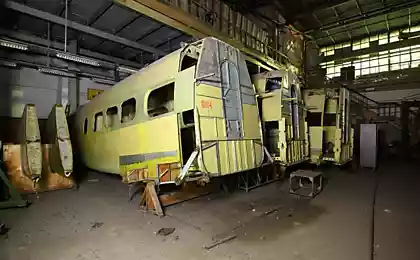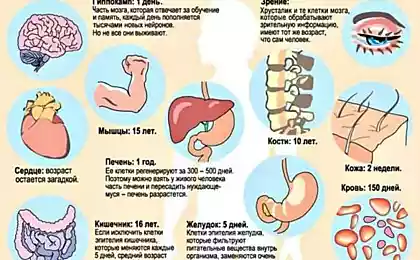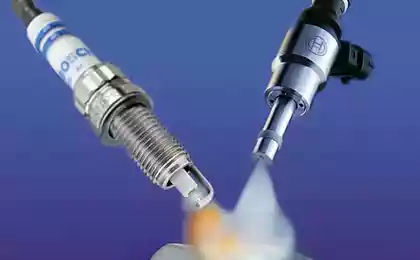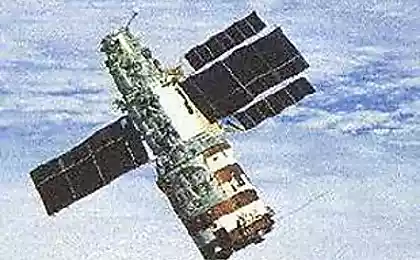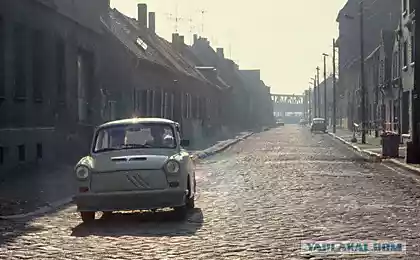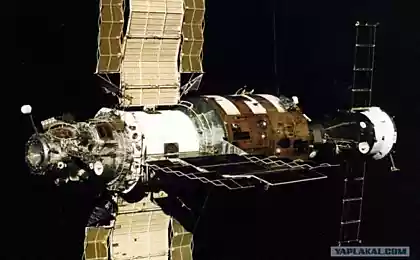1248
Department №601 MAI - "Space systems and rocket science"
Author photos and travel lab says, in April shooting took place in the laboratory of the Faculty of number 601 MAI - Space systems and rocket science. " It was the kind of shot because of the secrecy. Many of you I just can not show, though that may be the secret to the engines R-7, I do not understand, as in the internet and so this in bulk, but here at the Department of the R-7 - a secret product. But something there was really a secret, some products were generally covered with a tarpaulin. It was hard to remove anything that would not burn the most sensitive products, but something happened, and you can see below. To many articles I will try to describe, although some spacecraft I can not learn. Can you help them guess the purpose and name?
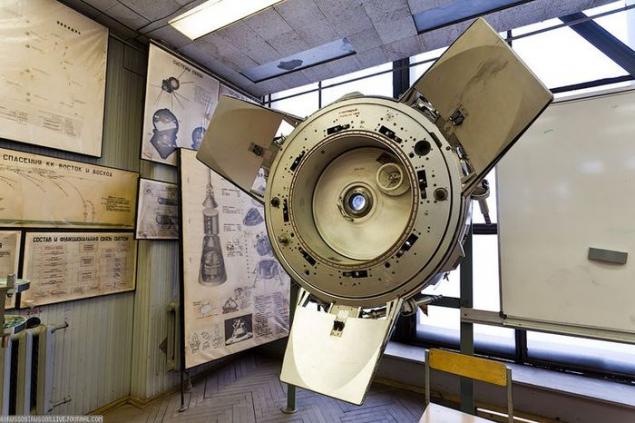
1. androgynous-peripheral docking assembly. Space docking mechanism used on the International Space Station. It is used for docking of the shuttle and shuttle to connect the Functional Cargo Block ("Dawn") to a sealed docking adapter (PMA-1). Similar OASIS system is used by the Chinese Shenzhou spacecraft, which allows it to dock with the ISS. OASIS was founded in Moscow Vladimir Syromyatnikova CB "Energy" and started the project "Soyuz-Apollo". The idea of creating a counterweight appeared uncomfortable systems such as "plug and sockets", so any APAS docking ring can be joined with any other docking ring OASIS, as both sides androgynous. Although each of these docking unit has an active and a passive side, both of them completely interchangeable. In the photograph, if I am not mistaken, it is represented by APAS-75, which was used in the "Soyuz-Apollo».
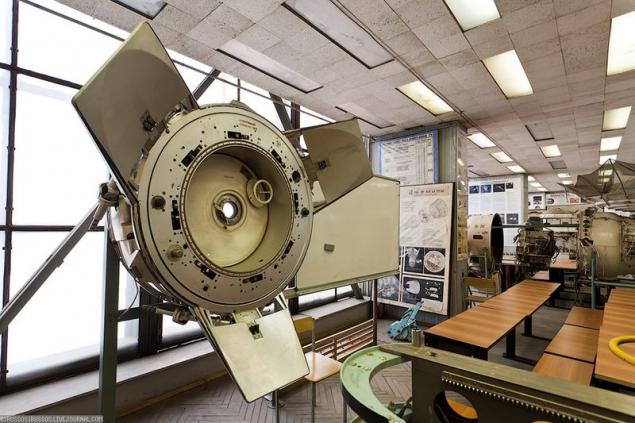
In the background you can see the satellites' Venera-8 ". According to her, on the moon, I would have 9 two separate post. Painfully interesting way was to land on these celestial bodies.
2. Again, if I'm not mistaken, this is the pin from the docking system Needle. And its earlier version, when you do not provide a transition through a node, and the astronauts had to move from one ship to another in space.
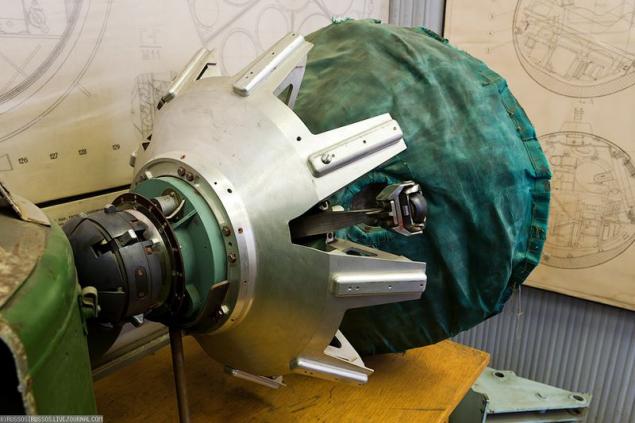
3. Stand for demonstration of needles. As a special rail docking assembly pulls another and docks.
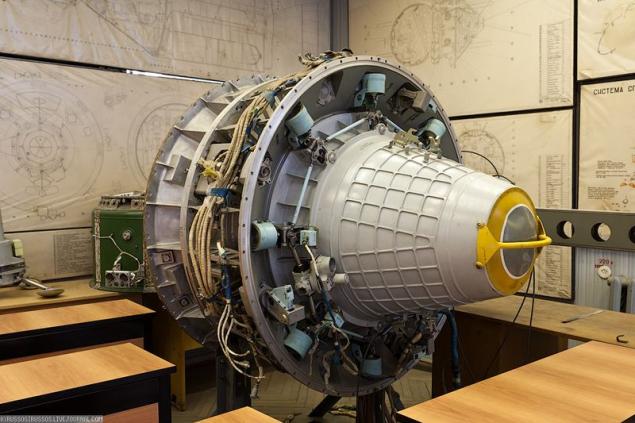
4. Some engine. Judging by the size it is likely The correction-brake motor.
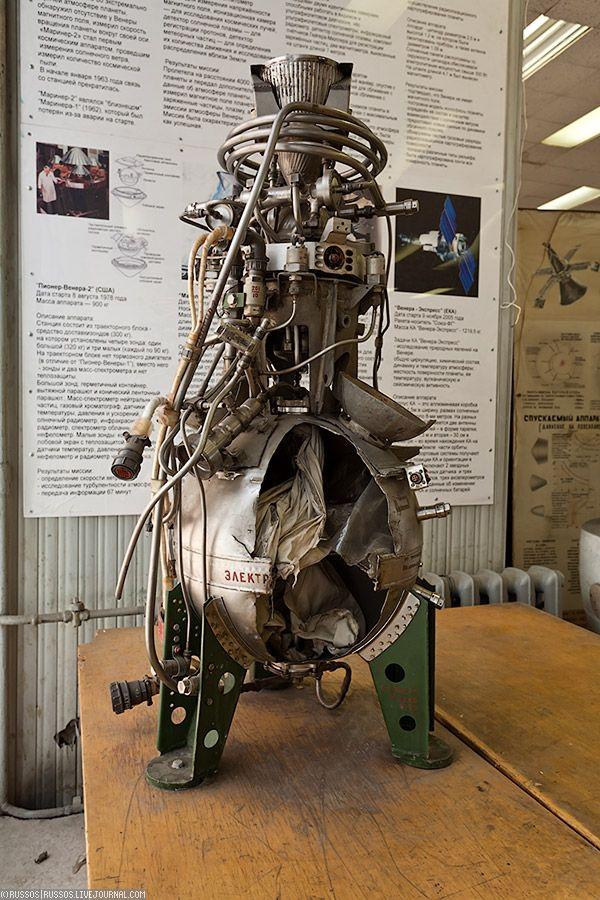
5. Detail lander Marsinskoy program.
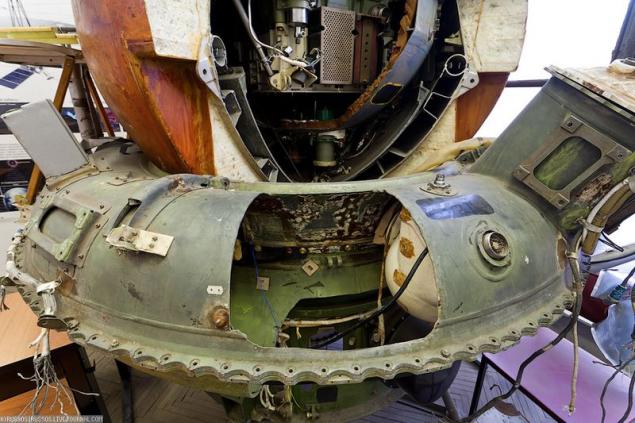
6. Spacecraft inside.
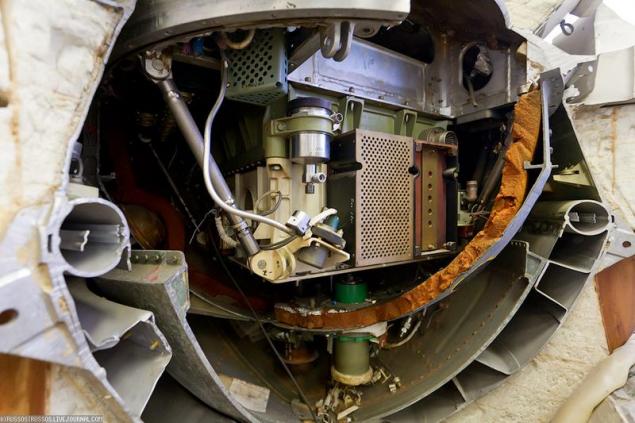
7. It is the main hall. On the left you can see the Soviet honesty, then two satellites. I do not know what.

8. Lunar ship (LC). About the Soviet lunar program has been written so much stuff that I do not see any reason that either quote it. If you want, here are links to Wikipedia and buran.ru. And here are two more: one, two.
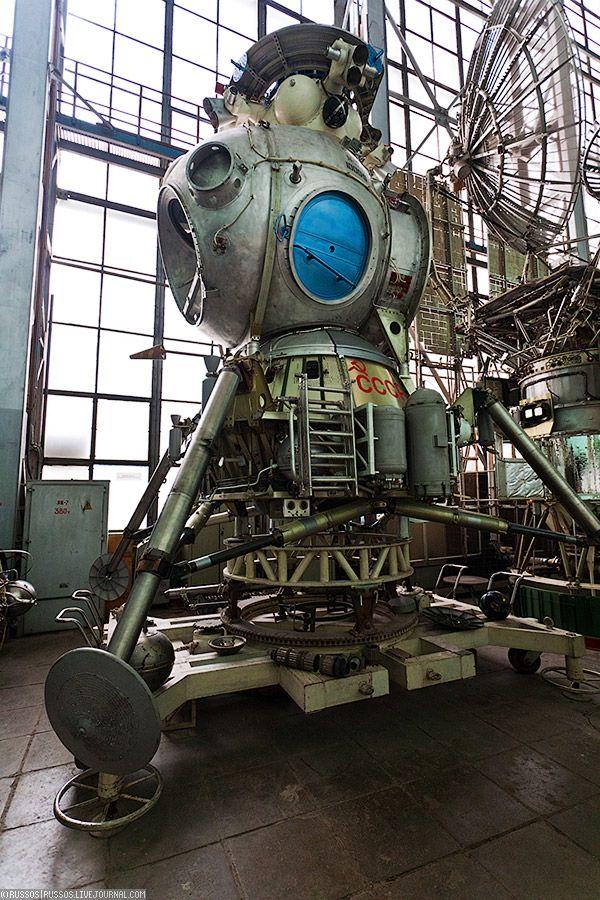
But I can not resist quoting Vladimir Ermolaev, who in his book "The Lay of Buranova ..." brought a clearer description of a lunar expedition. To quote a few fragments. In general, extremely I advise to read his book. - N-1 rocket was very large. "It's hard." For the development of the Moon. Or rather - "Drawing upon for Americana" in terms of "the first steps" on the moon. That is, the H-1 was delivered to the moon so-called "honesty." With our astronauts. And here begins the most "Circus", which set out from Lenin ... for reasons of economy it is not clear what, or because multiple backup systems or for lack of traction characteristics of the carrier, or for other reasons - hard to say, but ...! The crew of the lunar mission of the Soviet Union consisted of two people ... and when entering the lunar orbit - one remained largely the ship and cut circles around the moon, and the second - "in one!" In the descent module was "prilunitsya" on the surface of the moon itself ... "Lunnik" - the device is designed for landing on the lunar surface. It consists of a capsule with the astronaut, who stands on the platform, and the platform is on the feet. Well, like a flying saucer in science fiction films and pictures. Total - the height of the capsule on the feet - about 4 meters above the surface. Moon. Capsule - compartment astronaut - is an egg. Inside the egg bent skukozhennom a sitting astronaut. Although - "sitting" - it too. Let's just say - "is ..." Can you imagine the baby inside his pregnant mother? Like that. Or rather - exactly. Toko child not yet conceived - where and how to shit, piss. Do not think he is about it, he did not yet know what "think" ... and that is "fear", it - "bzda", it "fear of closed spaces," she's ... "Lunnik" gently (boom hope ) sits on the surface of the moon. The task "yaytsenavta" - to twist the side of the locking device, and then discard the hatch of the "egg." The hatch will moonlit steppe. And there, in the distance - a little earth. There's your house ... and there is a holy place - the toilet. With a fresh number of "Red Star". Better wipe away the material than the "Red Star" - no. There's a special soft newsprint. As for the purpose of folding hand-rolled cigarettes in the Soviet Army, and which to wipe away. Good this newspaper. Then - oh ... Then you need to pull out from under him ... ROPE LADDER !!! And throw it in the moon ... Then try to get out of the hatch ass forward, find the rope ladder and - go down there on the surface of the moon ... What immediately report to the Earth in the prescribed form. Type - "the task of the party and the government is satisfied." Then try to take pictures of themselves on the background of the lunar landscape. And do not believe there is any ... Scoop lunar soil, put the pennant with a portrait of Lenin ... But with someone else? Then explore the "honesty" for technical condition. Oil level, candles and other shock ... If necessary - replace ... Just a couple of sentences about Earth "well-being", "great achievements of Soviet science," the advantages of socialism ... And yet - do nothing more, reserve life-support suit running out, time to go home. All lunar excursion - an hour, well, two of the force. And then there is more to do. ONE? Then - the reverse procedure zalezaniyu in "egg" the rope ladder ... Ladder detach - and throw fuck. To the moon. Skukozhilas four death. Batten down the hatch. Ready to launch ... Start the engine, break away from the Moon, to go into lunar orbit to dock with the main ship, go to the bay and to the commander - the road home. [...] Soviet lunar mission could only perform biorobot. What are and were all of the first group of astronauts. Well, almost everything ... the then stage of space exploration have been one flight mission. Namely - do not touch anything in the spacecraft. Sidi bizdi ... and received the Order. And the next (or the one) military rank. And supercar of the "Volga". The first step on another planet, to make "The One" - a catastrophic shock tsunami on an emotional level, psychophysical zemlelunotryasenie ... Do not you think? Do you have children? Do you want to send your child alone on the moon? Do not be afraid, it will prepare, diapers and will suit even the Che ... Well there ... So what? [...] The difficult thing - "Soviet space." [...] - All right, Dad, told about the war, now about H-1 ever tell Th ... - So and to tell something ... Well, it's ... My telemetry worked fine. Engines there were not that ... All four start - over the hill ... - Only the engines? - Well ... - Well, if I flew - we would be well done? I mean - the country, the moon, space, hurray? - Prick knows ... - How is it? - Oh it on HUJ ... This H-1 ...
9. This landing leg honesty. Spider veins on the plate for a reason and is strictly designed element that deforms during landing and extinguishes special energy. And, it seems, still hooked on the ground.

10. LC.

11. You could spend hours looking at minor Circuits, labels, plugs, sockets For other beautiful fuck.
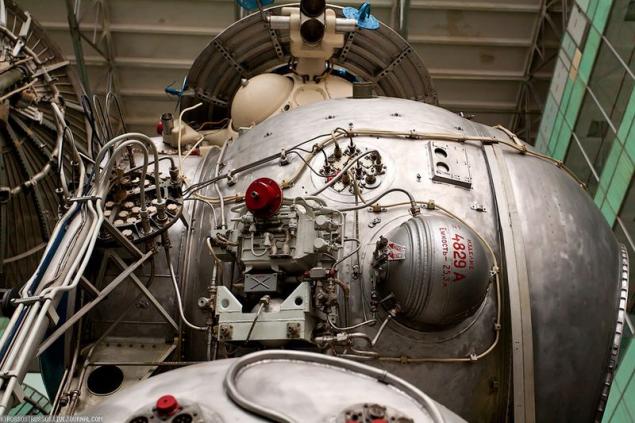
12. Listen, but also industrial beauty! This robot face really - mounted instrument compartment.
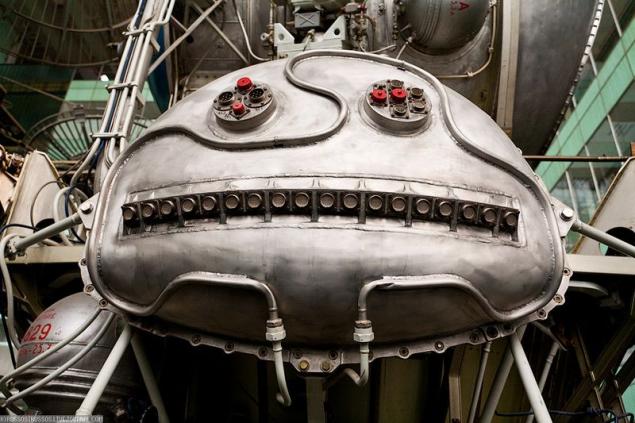
13. In this window "yaytsenavt" watching the descent to the moon.
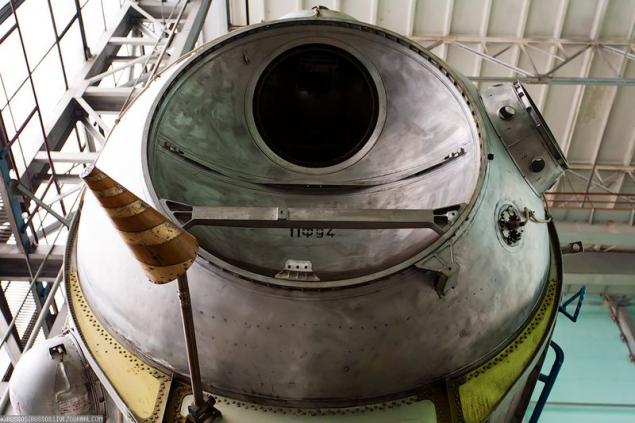
14. The satellite.
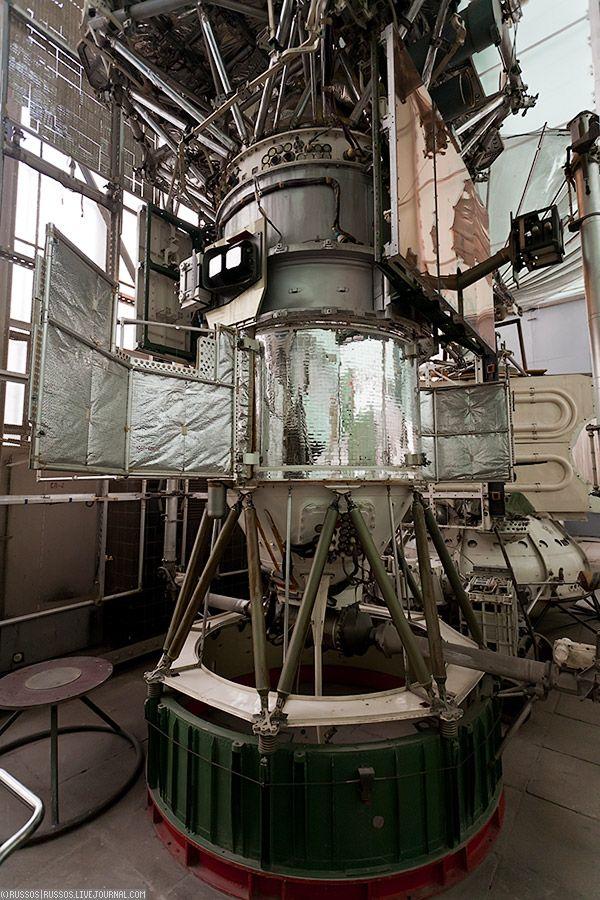
15.
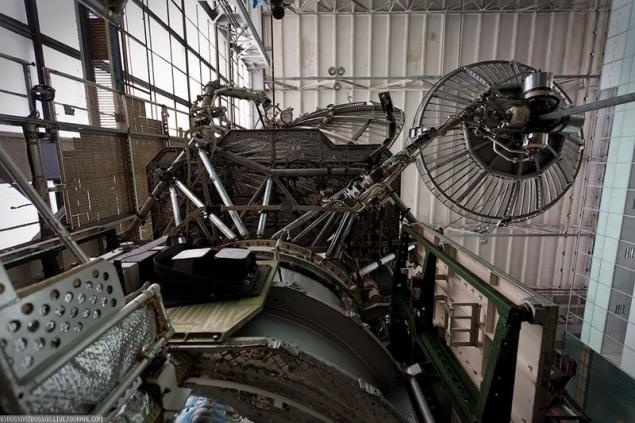
16. The Star, of course, then painted, but still it looks.

17. This micromotor (apparently gunpowder) to press the honesty to the moon, after the signal contact with the surface of the legs. Those. landing was the likelihood that honesty can bounce from the surface. To this did not happen, his booster.

18. Some spacecraft with large antennas.
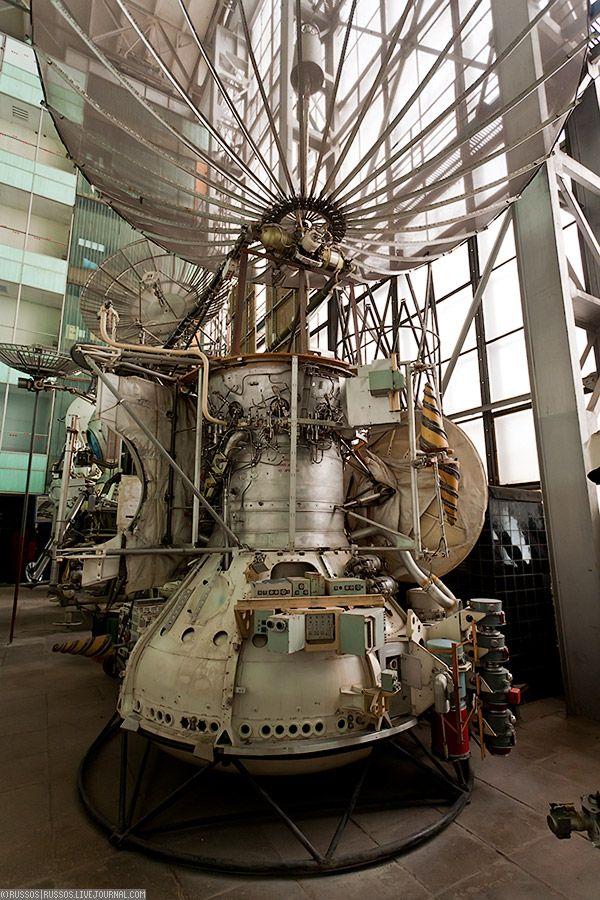
19. P / unit Main and P / Power backup.
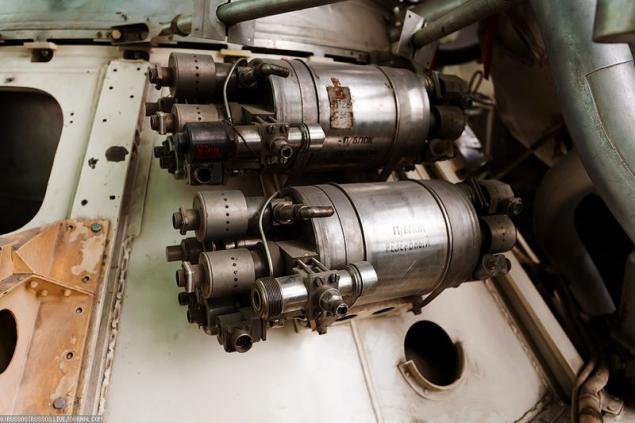
20. Antennas. If I am not mistaken omnidirectional.

21. That this hatch cosmonaut had to climb to the moon. It is true there have been staffing ladder. So maybe it's stories about the rope.
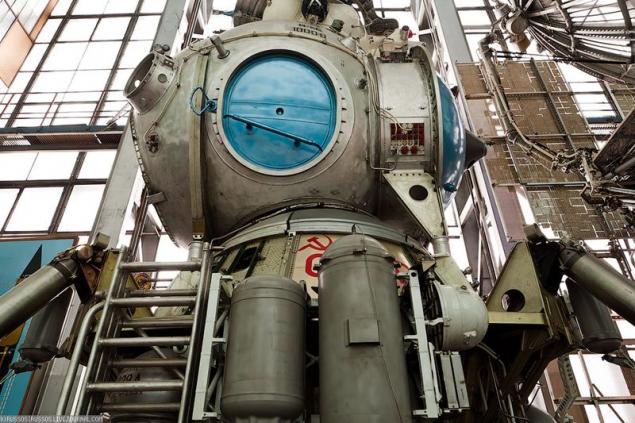
22. This position (and maybe more, and weight), the layout of the Mars-97. The lower part with balls (fuel tanks) - Fregat upper stage. In the Mars-97 does not have a Security Council panel (they only farm can be seen), and many more on the little things.

23. The lander spacecraft "Soyuz". When planting a massive bottom layer heat-shielding fires back (already at a low altitude), and at the bottom of open soft-landing engines, altimeter system and other necessary gizmos.
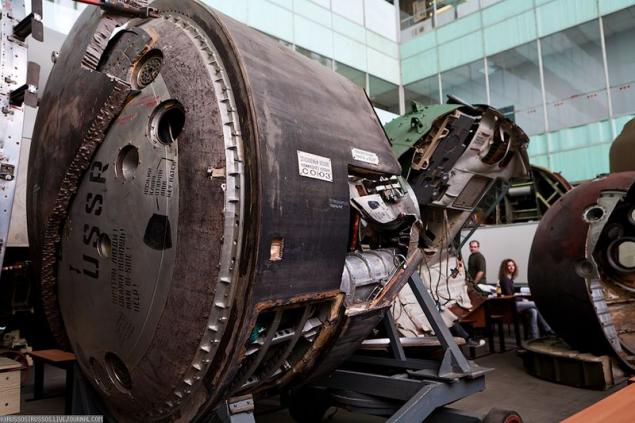
24. Open the hatch! Take the key!

25. The bottom of the close-up. Wieden load balancing - lead. Every flight is different loading of the ship, it depends on the astronauts, cargo and many other things. Therefore, the reference to balancing bottom prikleplyayut lead plates, which make a walk in space.
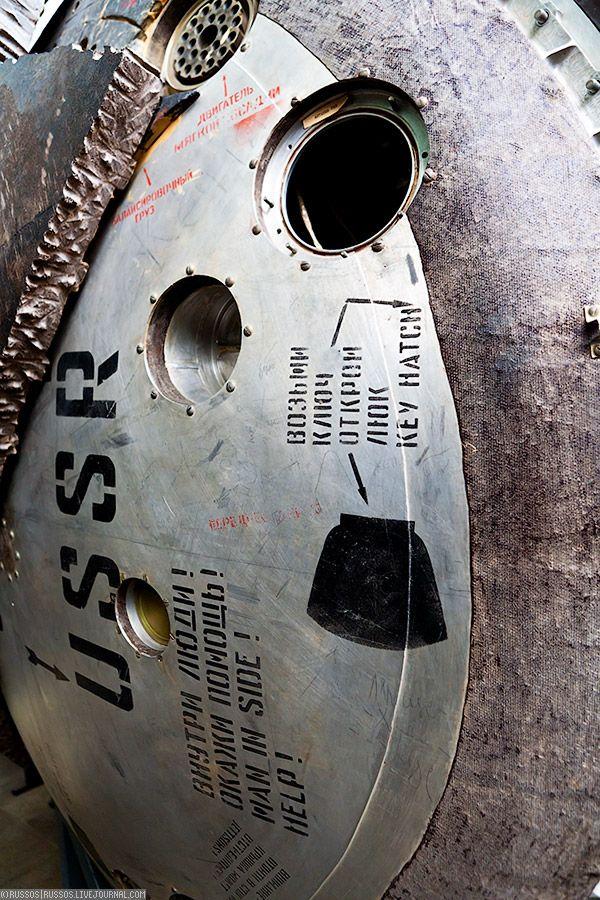
26. Suddenly. :) Student MAI.
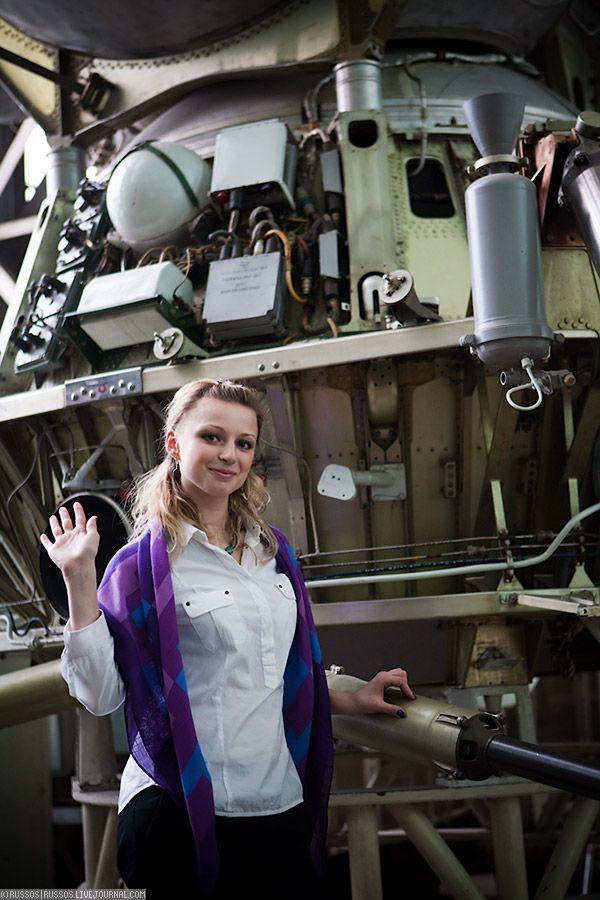
27.;)
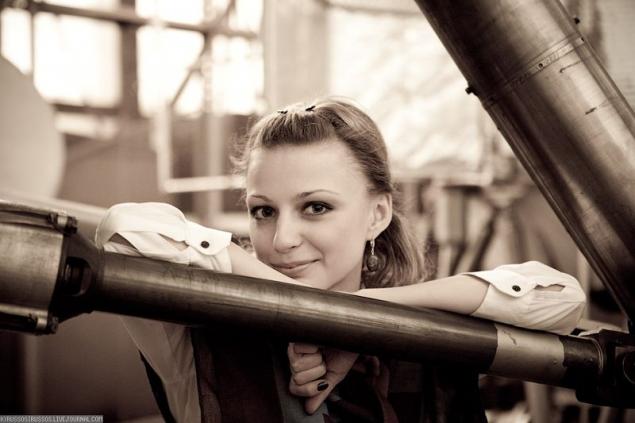
28. Even like that.

29. And in the room were full-time employment.

30.

31. The mount parachute system for the descent capsule (?). Somewhere there must be Brake force indicators, which shoot parachutes after landing.

32.
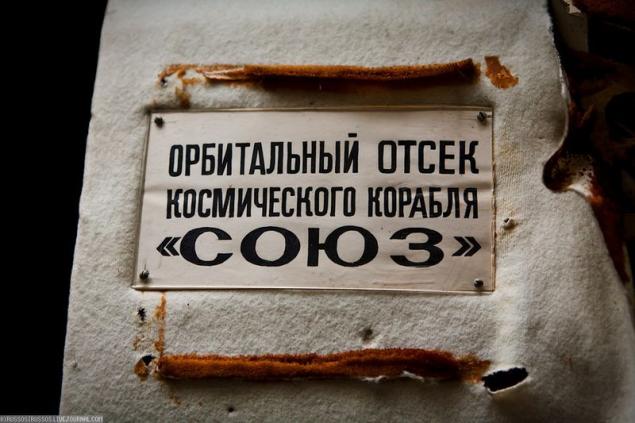
33. Inside the lander. Ye gods, how it closely. I do not understand how a person can skukozhilas this "chair."
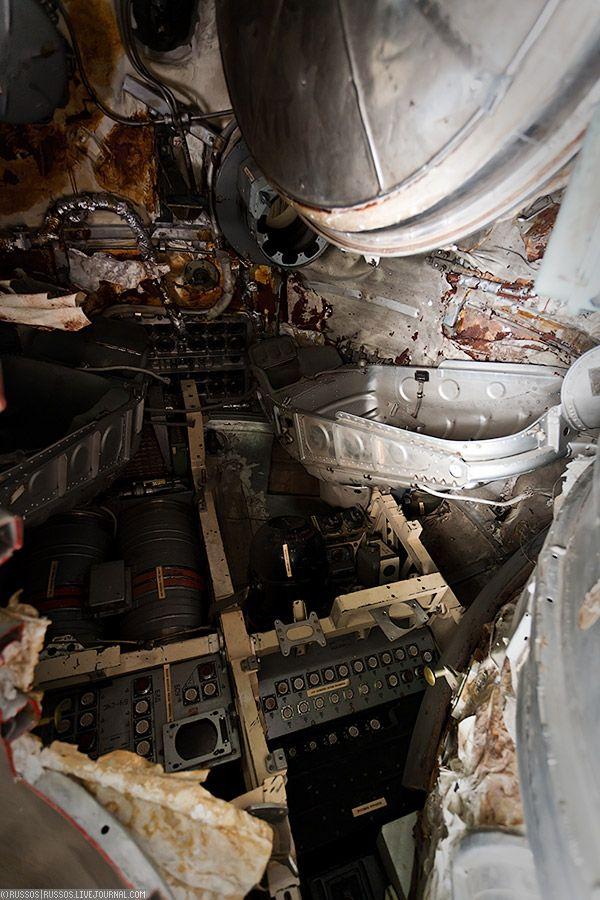
34. Household compartment Union. I did not understand what version of the Union is represented here, but there are signs this is the first series of the Union, but after the Union-11. Because of the tragic death of the crew of Soyuz-11 due to depressurization of the SA after the separation, the astronauts began to fly in space suits, but then the lander only two breaks. And only with the "T" series are back to a three-term crew, but also in spacesuits. At the bottom of the orbital module hatch is visible. Through him, the crew sits in the boat at the start, and through him, if necessary, spacewalks.
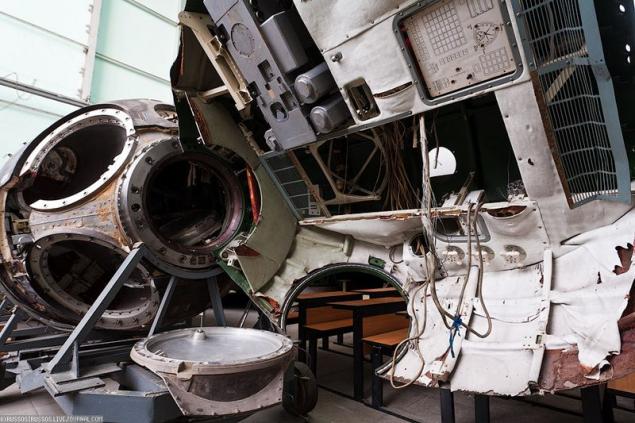
35. Parachute containers lander. The main system and replacement. April 24, 1967 while returning Union SA-1 was lost cosmonaut Vladimir Komarov. I do not left the main parachute will only exhaust, which was not enough and CA hit the ground at a speed of about 50 m / s and burned. Reserve parachute came out, but did not open, due to the fact that it is not wrapped around the lines otstrelennogo main parachute pilot chute system.
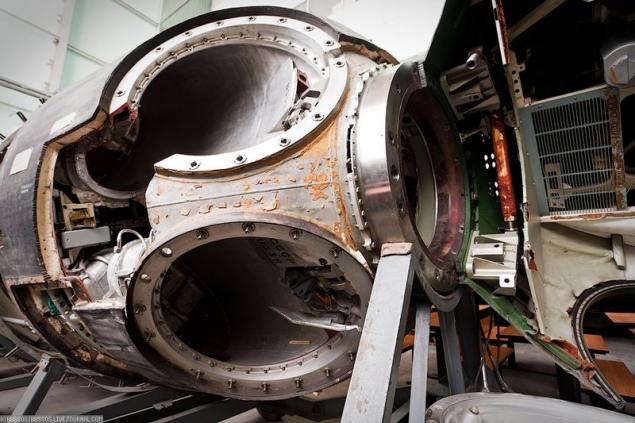
36. The spacecraft "Soyuz».
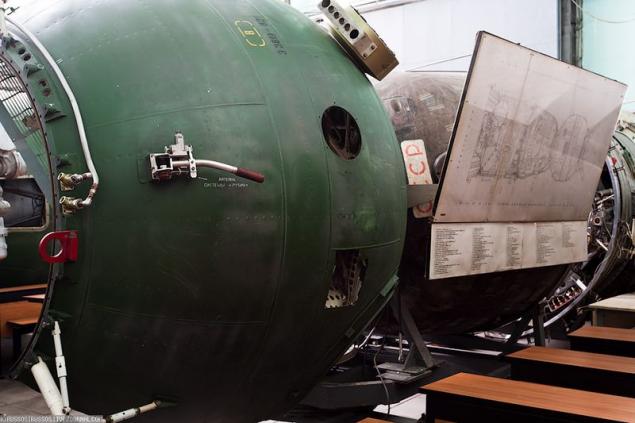
37. The device-service module Union.
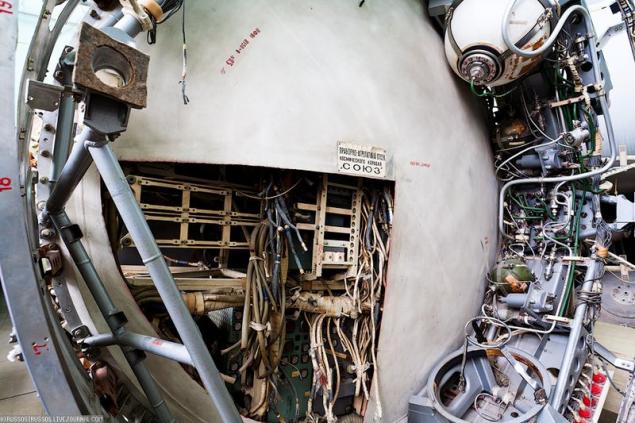
It was very interesting. This here is the living touch of the iron, which makes for a flight into space. Yes, behind the scenes there are still a lot of interesting, but alas. To see it, you have to become a student of this department. :)
via source

1. androgynous-peripheral docking assembly. Space docking mechanism used on the International Space Station. It is used for docking of the shuttle and shuttle to connect the Functional Cargo Block ("Dawn") to a sealed docking adapter (PMA-1). Similar OASIS system is used by the Chinese Shenzhou spacecraft, which allows it to dock with the ISS. OASIS was founded in Moscow Vladimir Syromyatnikova CB "Energy" and started the project "Soyuz-Apollo". The idea of creating a counterweight appeared uncomfortable systems such as "plug and sockets", so any APAS docking ring can be joined with any other docking ring OASIS, as both sides androgynous. Although each of these docking unit has an active and a passive side, both of them completely interchangeable. In the photograph, if I am not mistaken, it is represented by APAS-75, which was used in the "Soyuz-Apollo».

In the background you can see the satellites' Venera-8 ". According to her, on the moon, I would have 9 two separate post. Painfully interesting way was to land on these celestial bodies.
2. Again, if I'm not mistaken, this is the pin from the docking system Needle. And its earlier version, when you do not provide a transition through a node, and the astronauts had to move from one ship to another in space.

3. Stand for demonstration of needles. As a special rail docking assembly pulls another and docks.

4. Some engine. Judging by the size it is likely The correction-brake motor.

5. Detail lander Marsinskoy program.

6. Spacecraft inside.

7. It is the main hall. On the left you can see the Soviet honesty, then two satellites. I do not know what.

8. Lunar ship (LC). About the Soviet lunar program has been written so much stuff that I do not see any reason that either quote it. If you want, here are links to Wikipedia and buran.ru. And here are two more: one, two.

But I can not resist quoting Vladimir Ermolaev, who in his book "The Lay of Buranova ..." brought a clearer description of a lunar expedition. To quote a few fragments. In general, extremely I advise to read his book. - N-1 rocket was very large. "It's hard." For the development of the Moon. Or rather - "Drawing upon for Americana" in terms of "the first steps" on the moon. That is, the H-1 was delivered to the moon so-called "honesty." With our astronauts. And here begins the most "Circus", which set out from Lenin ... for reasons of economy it is not clear what, or because multiple backup systems or for lack of traction characteristics of the carrier, or for other reasons - hard to say, but ...! The crew of the lunar mission of the Soviet Union consisted of two people ... and when entering the lunar orbit - one remained largely the ship and cut circles around the moon, and the second - "in one!" In the descent module was "prilunitsya" on the surface of the moon itself ... "Lunnik" - the device is designed for landing on the lunar surface. It consists of a capsule with the astronaut, who stands on the platform, and the platform is on the feet. Well, like a flying saucer in science fiction films and pictures. Total - the height of the capsule on the feet - about 4 meters above the surface. Moon. Capsule - compartment astronaut - is an egg. Inside the egg bent skukozhennom a sitting astronaut. Although - "sitting" - it too. Let's just say - "is ..." Can you imagine the baby inside his pregnant mother? Like that. Or rather - exactly. Toko child not yet conceived - where and how to shit, piss. Do not think he is about it, he did not yet know what "think" ... and that is "fear", it - "bzda", it "fear of closed spaces," she's ... "Lunnik" gently (boom hope ) sits on the surface of the moon. The task "yaytsenavta" - to twist the side of the locking device, and then discard the hatch of the "egg." The hatch will moonlit steppe. And there, in the distance - a little earth. There's your house ... and there is a holy place - the toilet. With a fresh number of "Red Star". Better wipe away the material than the "Red Star" - no. There's a special soft newsprint. As for the purpose of folding hand-rolled cigarettes in the Soviet Army, and which to wipe away. Good this newspaper. Then - oh ... Then you need to pull out from under him ... ROPE LADDER !!! And throw it in the moon ... Then try to get out of the hatch ass forward, find the rope ladder and - go down there on the surface of the moon ... What immediately report to the Earth in the prescribed form. Type - "the task of the party and the government is satisfied." Then try to take pictures of themselves on the background of the lunar landscape. And do not believe there is any ... Scoop lunar soil, put the pennant with a portrait of Lenin ... But with someone else? Then explore the "honesty" for technical condition. Oil level, candles and other shock ... If necessary - replace ... Just a couple of sentences about Earth "well-being", "great achievements of Soviet science," the advantages of socialism ... And yet - do nothing more, reserve life-support suit running out, time to go home. All lunar excursion - an hour, well, two of the force. And then there is more to do. ONE? Then - the reverse procedure zalezaniyu in "egg" the rope ladder ... Ladder detach - and throw fuck. To the moon. Skukozhilas four death. Batten down the hatch. Ready to launch ... Start the engine, break away from the Moon, to go into lunar orbit to dock with the main ship, go to the bay and to the commander - the road home. [...] Soviet lunar mission could only perform biorobot. What are and were all of the first group of astronauts. Well, almost everything ... the then stage of space exploration have been one flight mission. Namely - do not touch anything in the spacecraft. Sidi bizdi ... and received the Order. And the next (or the one) military rank. And supercar of the "Volga". The first step on another planet, to make "The One" - a catastrophic shock tsunami on an emotional level, psychophysical zemlelunotryasenie ... Do not you think? Do you have children? Do you want to send your child alone on the moon? Do not be afraid, it will prepare, diapers and will suit even the Che ... Well there ... So what? [...] The difficult thing - "Soviet space." [...] - All right, Dad, told about the war, now about H-1 ever tell Th ... - So and to tell something ... Well, it's ... My telemetry worked fine. Engines there were not that ... All four start - over the hill ... - Only the engines? - Well ... - Well, if I flew - we would be well done? I mean - the country, the moon, space, hurray? - Prick knows ... - How is it? - Oh it on HUJ ... This H-1 ...
9. This landing leg honesty. Spider veins on the plate for a reason and is strictly designed element that deforms during landing and extinguishes special energy. And, it seems, still hooked on the ground.

10. LC.

11. You could spend hours looking at minor Circuits, labels, plugs, sockets For other beautiful fuck.

12. Listen, but also industrial beauty! This robot face really - mounted instrument compartment.

13. In this window "yaytsenavt" watching the descent to the moon.

14. The satellite.

15.

16. The Star, of course, then painted, but still it looks.

17. This micromotor (apparently gunpowder) to press the honesty to the moon, after the signal contact with the surface of the legs. Those. landing was the likelihood that honesty can bounce from the surface. To this did not happen, his booster.

18. Some spacecraft with large antennas.

19. P / unit Main and P / Power backup.

20. Antennas. If I am not mistaken omnidirectional.

21. That this hatch cosmonaut had to climb to the moon. It is true there have been staffing ladder. So maybe it's stories about the rope.

22. This position (and maybe more, and weight), the layout of the Mars-97. The lower part with balls (fuel tanks) - Fregat upper stage. In the Mars-97 does not have a Security Council panel (they only farm can be seen), and many more on the little things.

23. The lander spacecraft "Soyuz". When planting a massive bottom layer heat-shielding fires back (already at a low altitude), and at the bottom of open soft-landing engines, altimeter system and other necessary gizmos.

24. Open the hatch! Take the key!

25. The bottom of the close-up. Wieden load balancing - lead. Every flight is different loading of the ship, it depends on the astronauts, cargo and many other things. Therefore, the reference to balancing bottom prikleplyayut lead plates, which make a walk in space.

26. Suddenly. :) Student MAI.

27.;)

28. Even like that.

29. And in the room were full-time employment.

30.

31. The mount parachute system for the descent capsule (?). Somewhere there must be Brake force indicators, which shoot parachutes after landing.

32.

33. Inside the lander. Ye gods, how it closely. I do not understand how a person can skukozhilas this "chair."

34. Household compartment Union. I did not understand what version of the Union is represented here, but there are signs this is the first series of the Union, but after the Union-11. Because of the tragic death of the crew of Soyuz-11 due to depressurization of the SA after the separation, the astronauts began to fly in space suits, but then the lander only two breaks. And only with the "T" series are back to a three-term crew, but also in spacesuits. At the bottom of the orbital module hatch is visible. Through him, the crew sits in the boat at the start, and through him, if necessary, spacewalks.

35. Parachute containers lander. The main system and replacement. April 24, 1967 while returning Union SA-1 was lost cosmonaut Vladimir Komarov. I do not left the main parachute will only exhaust, which was not enough and CA hit the ground at a speed of about 50 m / s and burned. Reserve parachute came out, but did not open, due to the fact that it is not wrapped around the lines otstrelennogo main parachute pilot chute system.

36. The spacecraft "Soyuz».

37. The device-service module Union.

It was very interesting. This here is the living touch of the iron, which makes for a flight into space. Yes, behind the scenes there are still a lot of interesting, but alas. To see it, you have to become a student of this department. :)
via source

